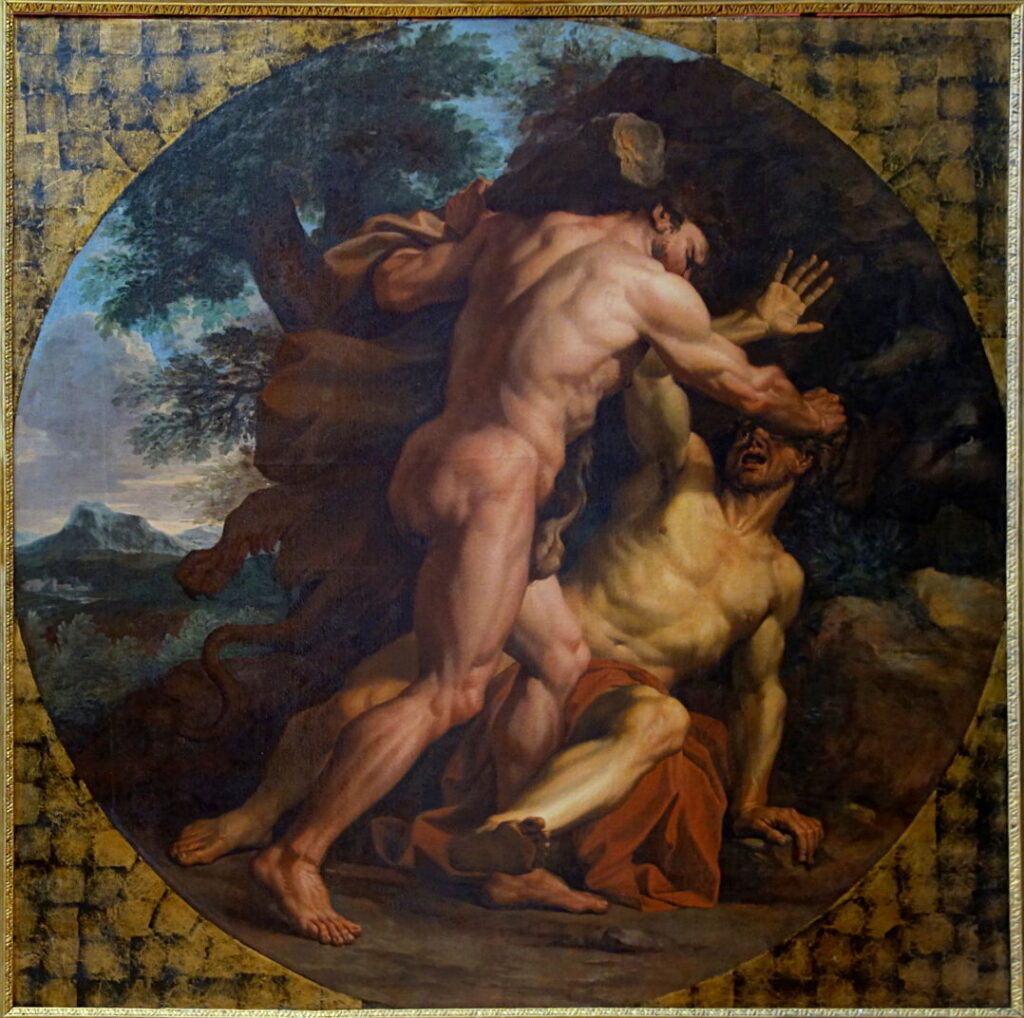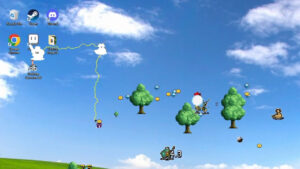Changing Paintings: 42 Wrestling for the Horn of Plenty

Ovid ended Book 8 of his Metamorphoses with a teaser, telling how the river god Achelous was able to transform himself into a snake or bull, and that he had recently lost one of the bull’s two horns. Book 9 opens by explaining how that came about.
With a little prompting from Theseus, Achelous resumes his narration, lamenting that he’s about to tell a story of a battle lost. He and Hercules both asked for the beautiful Deianira’s hand in marriage, forcing other suitors to resign their claims and leave the matter to them to plead their cases. Hercules wasn’t happy to do this in words, so rushed at his competitor to engage him in a fight.
Achelous gives a flattering account of the pair wrestling, eventually admitting that Hercules got the better of him and forced him onto his knees. The river god then shifted shape, changing first to a snake so he could slither away from his opponent. Hercules mocked him for that, reminding him of his conquest of the Lernean Hydra. When Hercules got a stranglehold on him, Achelous changed into his third and final form, that of a bull. Once again Hercules brought him down, and wrenched off one of his horns. The missing horn was transformed into the Horn of Plenty, cornucopia, and the guests were then served fruit in such a horn at their banquet.
Annibale Fontana (1540–1587), Plaque with Hercules and Achelous (c 1560-70), rock crystal, enamel, and gold, 10.3 x 13.3 cm, Walters Art Museum, Baltimore. Wikimedia Commons.
This exquisitely engraved rock crystal plaque by Annibale Fontana, showing Hercules and Achelous wrestling, is one scene from a life of Hercules. This was originally set with others into a gilded casket owned by the ducal Gonzaga family, of the city of Mantua in Italy. Hercules, on the right, wears his signature lion-skin, and Achelous is conventionally old, bearded, and shaggy.
Cornelis Corneliszoon van Haarlem (1562-1638), Hercules and Achelous (?1590), oil on canvas, 192 x 244 cm, location not known. Wikimedia Commons.
Cornelis van Haarlem’s painting of Hercules and Achelous, probably from around 1590, shows a late stage in the wrestling, with Achelous in the form of a bull, brought to the ground by Hercules, who is here trying to twist his horns off.
Guido Reni (1575–1642), Hercules and Achelous (1617-21), oil on canvas, 261 x 192 cm, Musée du Louvre, Paris. Wikimedia Commons.
Guido Reni’s Hercules and Achelous (1617-21) opts for a more conventional wrestling match, with Achelous still in his initial human form.
Noël Coypel (1628–1707), Hercules Fighting Achelous (c 1667-69), oil on canvas, 211 × 211 cm, Palais des Beaux-Arts de Lille, Lille, France. Wikimedia Commons.
Noël Coypel, the father of the better-known history painter Antoine Coypel, painted Hercules Fighting Achelous in about 1667-69. This too opts to show the pair during the first phase of their fight. In addition to wearing his lion-skin, Hercules wields his fearsome club, although Ovid doesn’t refer to its use on this occasion.
Nicolas Bertin (1667–1736), Hercules fighting Achelous (1715-30), oil on canvas, 108 × 137 cm, Muzeum Narodowe w Warszawie, Warsaw, Poland. Wikimedia Commons.
Nicolas Bertin’s Hercules fighting Achelous (1715-30) is more elaborate. Hercules has almost got Achelous onto the ground, and looks as if he’s about to punch him with his fist. Hercules’ club rests in the foreground. The woman at the right is Deianira, over whom they are fighting, and a winged goddess is ready to place the laurel wreath on the victor.
For once, the most detailed and magnificent account of one of Ovid’s myths is modern, painted in 1947 for a department store in Kansas City. Thomas Hart Benton’s Achelous and Hercules (1947) is a gem of narrative painting.
Thomas Hart Benton (1889–1975), Achelous and Hercules (1947), tempera and oil on canvas mounted on plywood, 159.7 × 671 cm, Smithsonian American Art Museum, Washington, DC. Wikimedia Commons.
At the centre, Hercules, stripped to the waist and wearing denim jeans, is about to grasp Achelous’ horns. Immediately to the right, Deianira is also shown in contemporary American form, with a young woman next to her bearing a laurel crown. They’re sat on the Horn of Plenty, and Benton is one of few to include this important reference.
To the left of centre, Benton shows a second figure of Hercules holding a rope, making this multiplex narrative. That is part of a passage referring to ranching and cowboys, and further to the left to the grain harvest. To the right, the Horn of Plenty links into the cultivation of maize (corn), the other major crop from the area.
Peter Paul Rubens (1577–1640) (workshop) and Jan Brueghel the Elder (1568–1625), Nymphs Filling the Horn of Plenty (c 1615), oil on panel, 67.5 x 107 cm, Koninklijk Kabinet van Schilderijen Mauritshuis, The Hague, The Netherlands. Wikimedia Commons.
My final painting to accompany this short story is another collaboration between the workshop of Peter Paul Rubens and Jan Brueghel the Elder: Nymphs Filling the Horn of Plenty (c 1615). Although it has no references to the fight between Hercules and Achelous, it’s good to see the staff preparing the second course of Achelous’ banquet.


